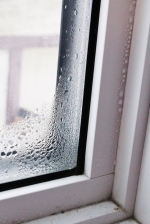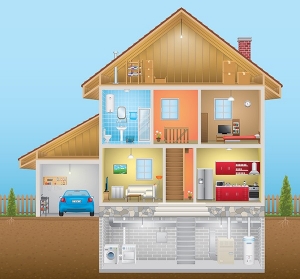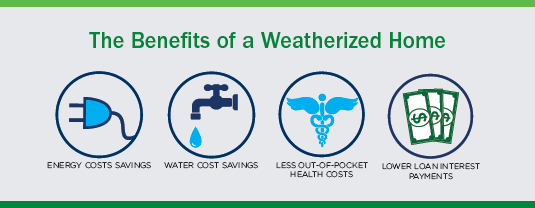Healthy Homes - Weatherization

What is weatherization?
How can weatherization benefit health?
How do I know if my home is weatherized?
What are signs of poor indoor air quality (IAQ)?
How can homes be weatherized?
What are the benefits of weatherization?
Who can assist with remediation?
Who is eligible for assistance?
Are there risks with weatherization?
Government partners
Other partners
Helpful resources
What is weatherization?
Weatherization is home improvement done to increase energy efficiency. Examples of weatherization are improved air sealing, insulation, moisture controls and ventilation. A weatherized home will be healthier, safer and more comfortable for living.
How can weatherization benefit health?
Weatherization can maintain or improve respiratory health, mental health, physical safety and wellness. Weatherization better manages temperatures and improves indoor air quality. Homes that get too cold in the winter or too warm in the summer increase the risk that residents will develop illness. Homes that have poor indoor air quality or asthma triggers increase the risk of illness. Everyone will benefit from a weatherized home. People with preexisting medical conditions like asthma, emphysema or COPD will likely benefit even more. Seniors and other people sensitive to extreme temperatures will also benefit. After their home was weatherized, people report having fewer bad health days and fewer doctor or emergency department visits.
How do I know if my home is weatherized?
Discomfort in your home is a clue that it may not be adequately weatherized. If you are experiencing unmanageable temperatures, uncomfortable indoor air conditions, or excess moisture your home will likely benefit from weatherization. A window with moisture condensed between the glass panels is an example of something not properly weatherized. A furnace that cannot maintain a comfortable indoor temperature is another example. A door or window that always seems drafty is another example. A leaky roof is a sure sign of the need for home improvement.
What are signs of poor indoor air quality (IAQ)?
Good indoor air quality is important for healthy breathing. Poor indoor air quality can cause difficulty breathing, dizziness, congestion or headache. It is important to know causes of poor indoor air quality. Uncontrolled indoor temperature and humidity are most important. Indoor allergens like dust, pollen, mold, secondhand smoke, and pet hair can cause breathing difficulties. Air pollutants from cleaning chemicals or pesticides are also bad.
Tennessee has all four seasons – winter, spring, summer and fall – each of which brings different weather conditions. These changing weather conditions affect both outdoor and indoor air quality.
How can homes be weatherized?
Air sealing, insulation, moisture control and ventilation are all types of weatherization. The US Department of Energy (DOE) has recommendations for these four topics:
What are the benefits of weatherization?
A weatherized home saves you money by lowering energy costs and improves the quality of life for those living in the home. Weatherization often saves a noticeable amount of money on your electric or natural gas bills. Weatherization benefits can save additional dollars that might have been spent on medical bills. For example, fewer ashthma triggers in a home result in fewer medical visits because of asthma attacks. People with weatherized homes, reported cost savings made it easier to pay their energy and medical bills, pay for food, and avoid high interest loans.
According to the Oak Ridge Institute for Science and Education, after a home has been weatherized there other health-related non-energy benefits have been noticed such as:
- Reduced Carbon Monoxide Poisonings
- Reduced Home Fires
- Reduced Thermal Stress on Occupants
- Reduced Asthma-Related Medical Care and Costs
- Increased Productivity at Work Due to Improvements in Sleep
- Increased Productivity at Home Due to Improvements in Sleep
- Fewer Missed Days at Work
- Reduced Use of High Interest, Short-Term Loans Increased Ability to Afford Prescriptions
- Reduced Heat or Eat Choice Dilemma Faced by Pregnant Women
- Reduced Need for Food Assistance
Who can assist with rememdiation ?
Several groups can help you determine if your home could benefit from weatherization. There are home improvement, air quality or energy efficiency companies who can improve your home. Some weatherization repairs may seem expensive, though many weatherization improvements will pay for themselves over time as you save money on utility bills.
A good place to start is by contacting your energy provider. Many utility companies have websites, newsletters or in-home services to help their customers understand energy consumption and weatherization. Some utilities will even offer an energy audit. They can also find out if you qualify for the U.S. Department of Energy Weatherization Assistance Program.
There are other groups that advocate for weatherization. These groups may have grant money available to help homeowners weatherize their home. For example, the Tennessee Housing Development Agency (THDA) provides grants for eligible homeowners. Depending on the circumstances, these services may fund home improvements or propose an action plan. There are other energy advocates in Tennessee who also help with weatherization.
Who is eligble for assistance?
The weatherization assistance program works to help low income households meet their energy and weatherization needs. Click to the Department of Energy Weatherization Assistance webpage for more information. The DOE shares ways to determine eligibility, how to apply, and the actions to take if accepted into the assistance program.
Are there risks with weatherization?
While there are many benefits of weatherization, there are possible side effects. For example, with a more tightly enclosed home, there is potential for indoor pollutants to become isolated inside the home. The EPA recommends inspecting of ventilation systems, testing for radon, and removing pollutant sources to minimize any risks.

Government Partners
U.S. Department of Energy
Weatherization Assistance Program (WAP)
www.energy.gov/eere/wipo/weatherization-assistance-program
U.S. Environmental Protection Agency (EPA)
Indoor Air Quality
www.epa.gov/indoor-air-quality-iaq/energy-weatherization-and-indoor-air-quality
Tennessee Valley Authority (TVA)
EnergyRight Solutions
energyright.com
Tennessee Housing Development Agency (THDA)
Weatherization
thda.org/business-partners/weatherization
Oak Ridge National Laboratory
Weatherization and Intergovernmental Programs Support
weatherization.ornl.gov
Other Partners
American Lung Association (ALA)
Healthy Air at Home
www.lung.org/our-initiatives/healthy-air/indoor/at-home
Helpful Resources
U.S. Department of Energy Weather Assistance Program
Fact Sheet
www.energy.gov/sites/prod/files/2018/06/f52/EERE_WAP_Fact%20Sheet-v2.pdf
Oak Ridge National Laboratory
Health and Safety Audit Design Manual
weatherization.ornl.gov/wp-content/uploads/pdf/2016_Present/ORNLTM2017-498.pdf
